
Although rationing was an important part of life in America during World War II, the US government was apprehensive about gasoline rationing. As a symbol of freedom of movement, the automobile represented everything American, and politicians feared riots and rebellion if they curtailed that freedom.
Gasoline Shortage
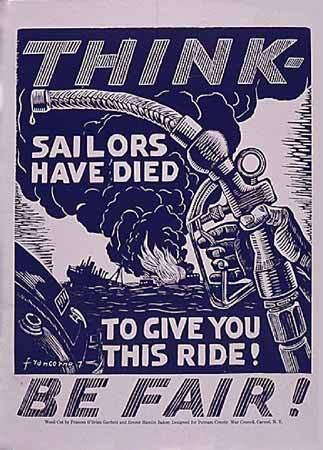
US poster, WWII
In early 1942, German U-boats ravaged Allied shipping off the US East Coast and in the Gulf of Mexico. Oil tankers were their favorite targets. The Allies needed oil for airplanes, ships, tanks, and to run factories, and the Germans hoped to cut off the supply. It didn’t take long for a gasoline shortage to develop on the US East Coast.
On April 9, 1942, gasoline deliveries were decreased to seventeen Eastern states, but to ensure fairness, rationing was required. On May 15, 1942, 8 million motorists in those seventeen states registered for gas ration cards, and rationing began on the East Coast on July 22, 1942.
Rubber Shortage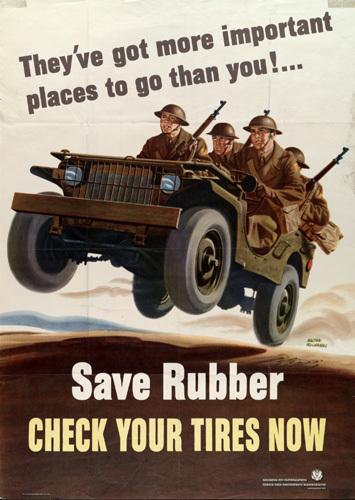
US poster encouraging conservation of rubber, WWII
Another serious issue that eventually led to nationwide gasoline rationing was the rubber shortage. The United States didn’t have enough rubber for military needs, much less civilian needs. While tires and other rubber items were rationed, the simplest way to reduce wear and tear on tires was to restrict driving.
Drive Less
US poster, 1944
On Dec. 1, 1942, a nationwide Victory speed limit of 35 mph was instituted, since higher speeds removed tread more quickly. Lightweight Victory Bicycles were introduced in March 1942, but were rationed to war workers and certain professionals and only when public transportation wasn’t available – and all other bicycle production ceased.
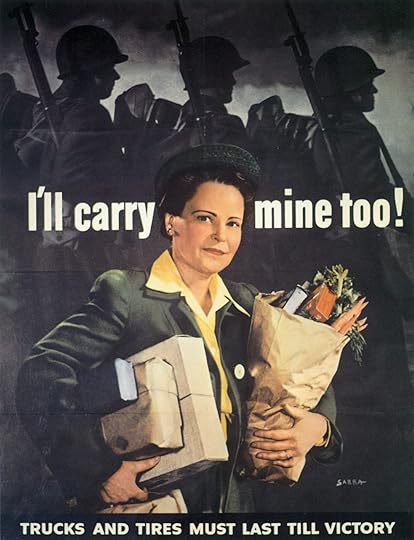
US poster, 1943
People were encouraged to use public transportation and their own two feet. Commuters were told to “Carry more to win the war,” and to share rides or form car clubs. Employers experimented with staggered shifts to reduce traffic – and therefore, gasoline use.
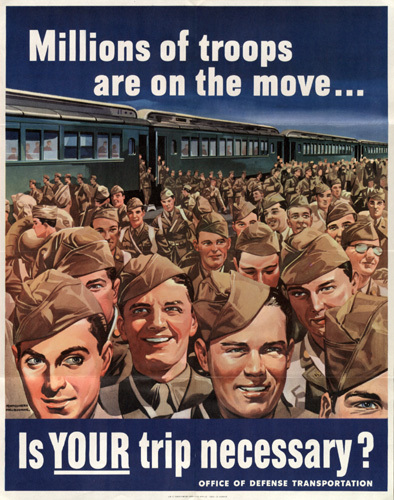
US poster, WWII
Pleasure driving was banned and the “Vacation at Home” was promoted, not just to save gas and rubber, but due to the strain on the nation’s train system by military transport.
Fewer Cars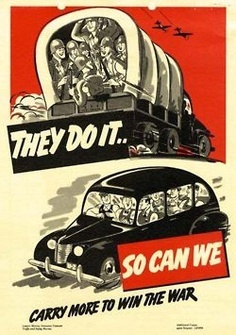
US poster encouraging car clubs, WWII
Car manufacturing stopped on Jan. 1, 1942, and no new automobiles could be purchased after Feb. 22, 1942. A small stock was held in reserve for critical replacements. The auto manufacturers converted their assembly lines to produce jeeps, tanks, and bombers, while the American consumer made do. Car theft became a larger problem than ever. On July 1, 1945, automobile production was allowed again, and the first car rolled off the assembly line on Aug. 30, 1945 – a Hudson Super Six coupe.
See this excellent article on the National WWII Museum blog about cars during the war.
Nationwide Gasoline RationingAlthough the U-boat menace decreased late in 1942, the rubber shortage remained critical. On Nov. 26, 1942, the government announced that nationwide gasoline rationing would go into effect Dec. 1, 1942. The program continued until Aug. 18, 1945.
Stickers and Coupons
Poster explaining US gasoline rationing cards in WWII
The American public learned to deal with an elaborate system. Every motorist was issued a windshield sticker displaying a letter. Some of these categories changed, emerged, or were eliminated during the war:
A: most motorists – 3 gallons/week, reduced to 2 gal/wk March 22, 1944B: for war workers who shared rides with 3 or more passengers – 8 gal/wkC: essential occupational use, such as physicians, clergy, and mail carriersD: motorcyclesE: emergency vehicles such as ambulances, police, fire – unlimitedR: non-highway use, such as farm vehicles – unlimitedT: truckers, instituted January 1, 1944 – unlimitedX: a controversial sticker for VIPs – unlimited
At the gas station, the attendant checked the windshield sticker and took the required number of ration book coupons – also marked with the appropriate letter. Of course, payment was also required – about 19 cents/gallon.
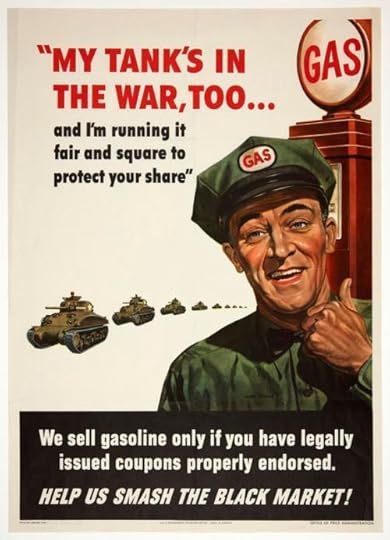
US poster, WWII (Franklin D. Roosevelt Presidential Library & Museum: MO 2005.13.44.14)
Gas ShortageDespite rationing, a serious gas shortage developed early in 1944. The high military use and restricted shipping contributed to this problem. In January 1944 on the West Coast, very little gasoline was available – and none at all in Sacramento, California, not even for emergency vehicles. On March 22, 1944, “A” class drivers were further restricted to 2 gallons/week.
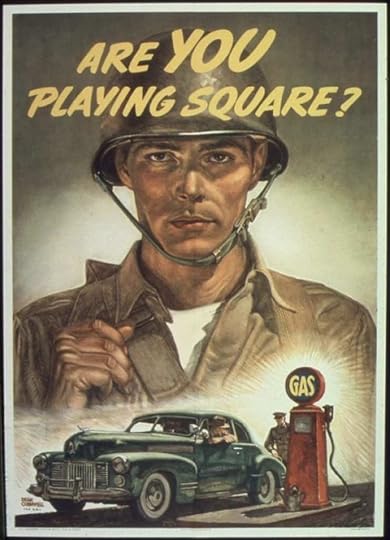
US poster, WWII
Not everyone complied. The black market became quite profitable, cases of gas siphoning made the front page of small-town newspapers, and several ration book forgery rings were broken up.
How do you think modern-day Americans would deal with these restrictions?
The post
Make It Do – Gasoline Rationing in World War II first appeared on
Sarah Sundin.
 newest »
newest »
 newest »
newest »
 I think modern day Americans wouldn't be able to handle this at all..... Not all people, but generally speaking Americans have become too soft and selfish in many ways. As we saw during the height of the pandemic, many people wouldn't even wear face coverings in public for the good of their community/ public health as a whole. Unfortunately nowadays everything is about "self" and " me and my rights" and there is no concept of having to sacrafice for a higher purpose/ greater good/ the good of others anymore.
I think modern day Americans wouldn't be able to handle this at all..... Not all people, but generally speaking Americans have become too soft and selfish in many ways. As we saw during the height of the pandemic, many people wouldn't even wear face coverings in public for the good of their community/ public health as a whole. Unfortunately nowadays everything is about "self" and " me and my rights" and there is no concept of having to sacrafice for a higher purpose/ greater good/ the good of others anymore.














